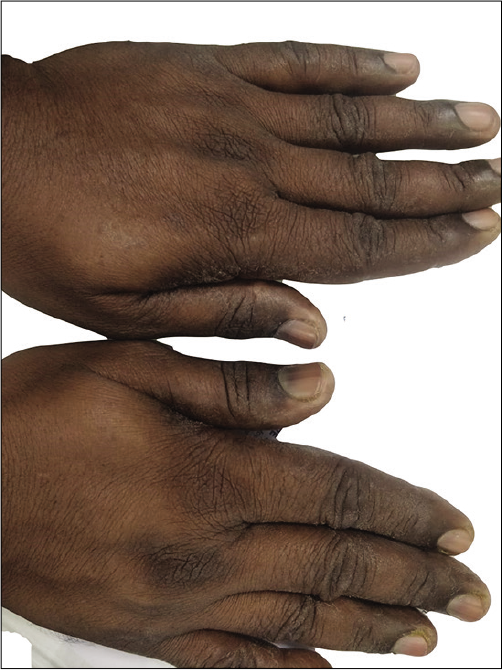Translate this page into:
The potential underestimated side effect of hydroxyurea
*Corresponding author: Rishu Vidhatri, Department of Hematology, NRS Medical College and Hospital, Kolkata, West Bengal, India. rishuvidhatrib19@gmail.com
-
Received: ,
Accepted: ,
How to cite this article: Vidhatri R. The potential underestimated side effect of hydroxyurea. J Hematol Allied Sci 2021;1:86-7.
A 43-year-old male known case of post essential thrombocythemia myelofibrosis was on hydroxyurea (HU) at a dose of 500 mg per day for the past 3 years and was doing well. But for the past 2 months, he complained of blackish pigmentation over both hands and feet. On examination, there were patchy areas of hyperpigmentation involving bilateral dorsum of hands [Figure 1], foot mainly in peri malleolar area [Figure 2], and nails of proximal one-third of thumb and big toe. All routine investigations were within normal limits except mild macrocytic anemia (Hb 11.4 g/dL, PCV-33.4%, and MCV-114.7fL). Other causes of cutaneous hyperpigmentation such as Vitamin B-12 deficiency, hyperbilirubinemia, Addison’s disease, Cushing’s syndrome, hyperthyroidism, hemosiderosis, scleroderma, and HIV were ruled out. At the time of presentation, he was not taking any other drug that could have caused hyperpigmentation, and thus HU was attributed as the cause of hyperpigmentation. The therapy was interrupted which lead to spontaneous recovery. HU arrests cells in the S phase of the cell cycle by blocking ribonucleotide reductase. It is known to cause a spectrum of cutaneous side effects ranging from hyperpigmentation to serious side effects such as ulcers and non-melanoma skin cancer requiring treatment interruption. The skin lesion is secondary to cytologic damage to keratinocytes and collagen fibers. This case highlights the importance of an underestimated cutaneous side effect of HU and the need for thorough skin examination before and during therapy to avoid serious side effects.

- Hyperpigmentation of dorsum of hand.

- Longitudnal hyperpigmentation of nails and patchy areas of pigmentation involving lateral malleolar region.
Declaration of patient consent
The authors certify that they have obtained all appropriate patient consent.
Financial support and sponsorship
Nil.
Conflicts of interest
There are no conflicts of interest.





